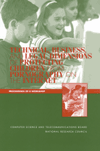|
|

Tools and Strategies for Protecting Kids from Pornography and Their Applicability to Other Inappropriate Internet Content
COMPLETED
Upcoming presentations and discussions of the final report (updated 28 May 2003)
Media coverage of this report
Details about the Public Briefing held on May 2, 2002
Listen to the Public Briefing [RealPlayer required]
Opening Statement by committee chair Dick Thornburgh
Visit this project's dedicated website
CALL FOR REVIEWERS (expired)
Publications
 Youth, Pornography, and the Internet examines approaches to protecting children and teens from Internet pornography, threats from sexual predators operating on-line, and other inappropriate material on the Internet. It discusses social and educational strategies, technological tools, and policy options for how to teach children to make safe and appropriate decisions about what they see and experience on the Internet. 2002.
Youth, Pornography, and the Internet examines approaches to protecting children and teens from Internet pornography, threats from sexual predators operating on-line, and other inappropriate material on the Internet. It discusses social and educational strategies, technological tools, and policy options for how to teach children to make safe and appropriate decisions about what they see and experience on the Internet. 2002.
 Technical, Business, and Legal Dimensions of Protecting Children from Pornography on the Internet: Proceedings of a Workshop contains edited transcripts of the presentations and discussions from a workshop focusing on some of the technical, business, and legal factors that affect how one might choose to protect kids from pornography on the Internet. It is not intended to be a comprehensive review of all of the technical, business, and legal issues that might be relevant to this subject. 144 pages, 2002.
Technical, Business, and Legal Dimensions of Protecting Children from Pornography on the Internet: Proceedings of a Workshop contains edited transcripts of the presentations and discussions from a workshop focusing on some of the technical, business, and legal factors that affect how one might choose to protect kids from pornography on the Internet. It is not intended to be a comprehensive review of all of the technical, business, and legal issues that might be relevant to this subject. 144 pages, 2002.
 Nontechnical Strategies to Reduce Children's Exposure to Inappropriate Material on the Internet: Summary of a Workshop summarizes a workshop organized around four topics: developmental considerations for defining inappropriate material and the effects of exposure to sexually explicit and other harmful materials; children's use patterns and experiences on the Internet; innovative approaches and existing efforts to use nontechnological strategies; and opportunities to bridge research, policy, and practice. 104 pages, 2001.
Nontechnical Strategies to Reduce Children's Exposure to Inappropriate Material on the Internet: Summary of a Workshop summarizes a workshop organized around four topics: developmental considerations for defining inappropriate material and the effects of exposure to sexually explicit and other harmful materials; children's use patterns and experiences on the Internet; innovative approaches and existing efforts to use nontechnological strategies; and opportunities to bridge research, policy, and practice. 104 pages, 2001.
Project Scope
The NRC is undertaking this project at the request of the U.S. Congress to examine tools and strategies for protecting kids from pornography and their applicability to other inappropriate Internet content. The subject of controlling children's Internet access to pornography is charged politically and emotionally in the national debate. Other areas do provoke public concern, but pornography on the Internet is and has been a major focus of national debate for quite some time. Through its primary focus on Internet pornography and threats to children from sexual predators on the Internet, the final report will also, and to a lesser extent, include:
- an objective description of the risks and benefits of various tools and strategies for addressing pornography that might be used to protect children from inappropriate material on the Internet;
- an explication of how "packages" of different technological and non-technological tools and strategies can be used together to enable local approaches for protecting children from inappropriate material on the Internet; and
- case studies of how different communities have approached the problem of protecting children from exposure to pornographic material on the Internet and, again, what those lessons teach about other inappropriate material.
Providing a better understanding of different tools and strategies can promote a more reasoned consideration of various public policy options as well as more informed approaches that are locally implementable. The study is expected to provide a foundation for a more coherent and objective local and national debate on the subject of Internet pornography, but will avoid making specific policy recommendations that embed particular social values in this area.
This study originated in a Congressional mandate to the Attorney General by the U.S. Congress in
Public Law 105-314 (Protection of Children from Sexual Predators Act of 1998) Title IX, Section 901.
Members of the Study Committee
Richard Thornburgh, chair, Kirkpatrick & Lockhart LLP
Nicholas J. Belkin, Rutgers University School of Library and Information Science
The Reverend William J. Byron, S.J., Georgetown University
Sandra L. Calvert, Georgetown University
David Forsyth, University of California, Berkeley
Daniel Geer, @stake, Inc.
Linda Hodge, National PTA
Margaret Honey, EDC's Center for Children and Technology
Marilyn Mason, Council on Library and Information Resources
Milo Medin, Excite@Home
John B. Rabun, National Center for Missing & Exploited Children
Robin Raskin, Ziff Davis Media
Paul Resnick (resigned)
Robert Schloss, IBM's Thomas J. Watson Research Center
Janet Ward Schofield, University of Pittsburgh
Geoffrey R. Stone, University of Chicago
Louis W. Sullivan (resigned)
Winnie Wechsler, Independent Consultant
Staff
Herb Lin, Senior Scientist (Study Director)
Gail Pritchard, Program Officer
Janice Sabuda, Senior Project Assistant
Marjory S. Blumenthal, Executive Director
Sponsors
Partial support for this project is being provided by:
U.S. Department of Justice - Office of Juvenile Justice and Delinquency Prevention
U.S. Department of Education - Office of Educational Technology
Microsoft
The Kellogg Foundation
IBM
|
|
|
